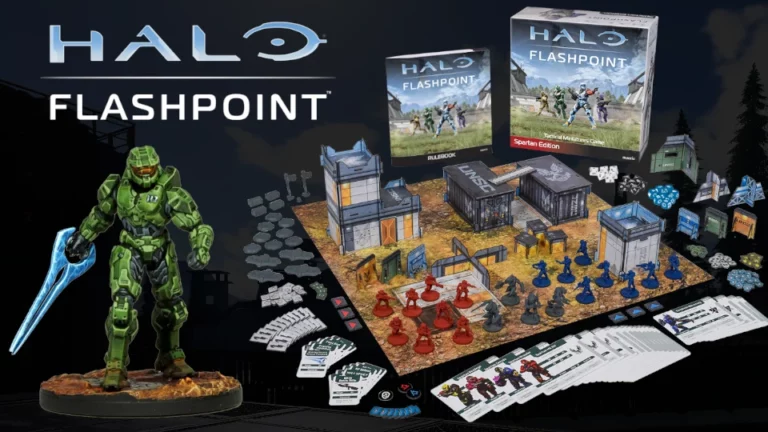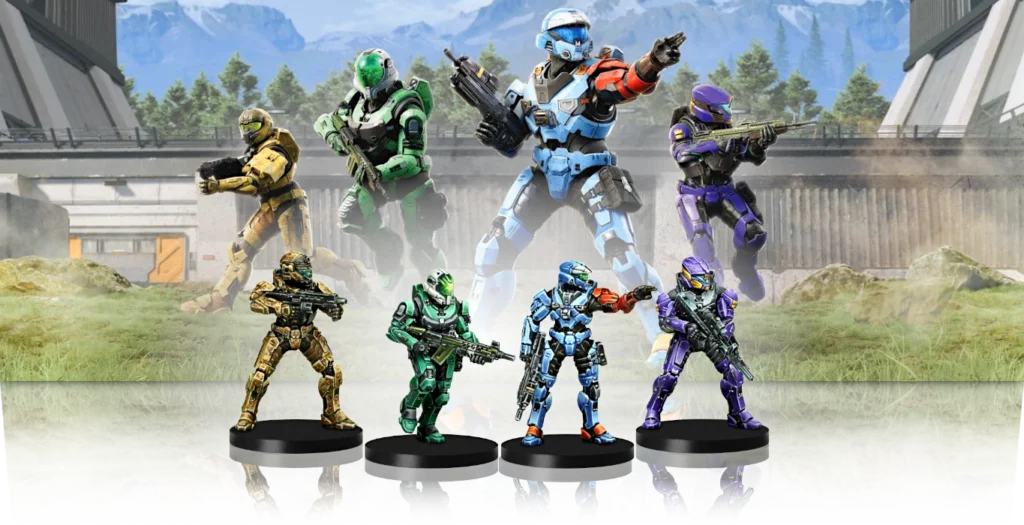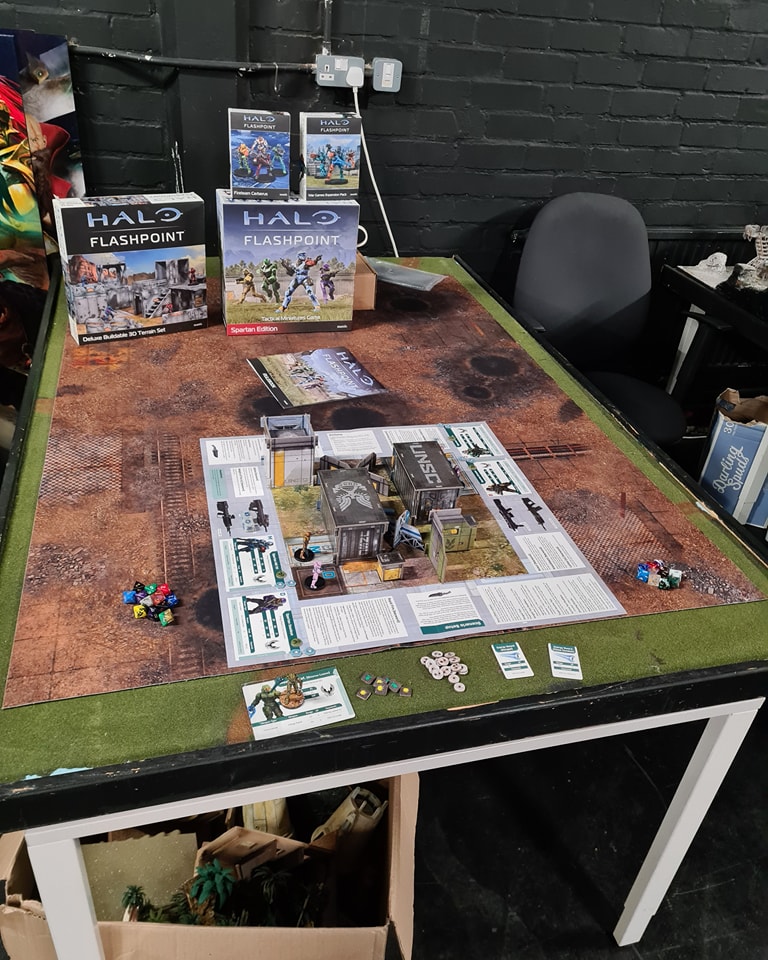
Launching in late 2024, Halo: Flashpoint by Mantic Games
Halo: Flashpoint miniature game brings one of the most iconic sci-fi universes into the realm of tabletop miniatures. For over two decades, Halo has been a cultural touchstone in video games, shaping multiplayer shooters and inspiring countless late-night battles across LAN parties and Xbox Live. Now, Mantic has taken on the challenge of translating that digital magic into a physical, tactile experience that is both accessible to newcomers and deep enough for seasoned gamers.
This article explores what makes Halo: Flashpoint unique, how it simplifies the wargaming experience, and why it might become a lasting bridge between video gamers and tabletop hobbyists. From simplified mechanics to community potential, here is a full introduction to the game.
A Heritage of Action: Halo Comes to Miniatures
Halo has always been about cinematic battles, iconic characters, and fast-paced team skirmishes. The question was how to bring those elements to a medium where turns are slower, rules are thicker, and hobby barriers can intimidate new players.
What is Halo: Flashpoint, the New Miniature Game?
Halo’s legacy and its leap to the tabletop
Mantic’s solution is a system designed to strip away the hardest entry barriers while keeping the tactical flavor that defines Halo. Instead of long rulebooks, complex measuring tools, or delicate assembly, Halo: Flashpoint is built to get players from box to battlefield in minutes. The result is a game that feels familiar to Halo veterans while being approachable for people whose only tabletop experience might be Monopoly or Catan.
Simplifying Miniature Wargaming for New Players
How Mantic Games designed Halo: Flashpoint for accessibility
Halo: Flashpoint stands out because it actively lowers the learning curve. Mantic has designed the starter sets and mechanics to make the game playable without prior hobby experience.
- Pre-painted Miniatures Ready to Play
The models come pre-built and pre-colored in classic red and blue. There is no need for glue, paint, or hobby knives. This eliminates one of the biggest hurdles that often scares off newcomers. Players can open the box and start rolling dice immediately. For Halo fans who never considered themselves hobbyists, this makes the game instantly welcoming. - Cube-Based Movement and Range
Measuring sticks and tape measures are replaced with an 8×8 grid of cubes. Movement and shooting are counted in cubes rather than inches. This reduces confusion, keeps the pace brisk, and prevents arguments about measurement. The cube system also encourages tactical positioning while remaining easy to grasp. - Printed Rules on Playmat for Beginners
One side of the double-sided playmat includes rules printed directly on it. This lets players learn by doing instead of flipping through rulebooks. For families, younger players, or complete beginners, this feature turns the learning process into part of the play experience. - Straightforward Dice Mechanics
Combat begins with a standard three-dice pool, with extra dice awarded for clever positioning or catching enemies out of cover. Results are checked against stats, with a roll of four or higher on a D8 counting as a success. The “headshot” mechanic, where rolling an eight allows another roll, keeps combat exciting and unpredictable while echoing Halo’s critical hits. - Limited Unit Types in Starter Sets
The base sets contain a small roster, mainly Spartans, with straightforward abilities. This keeps the learning curve smooth and avoids overwhelming new players with dozens of profiles. Once the basics are understood, expansions can add complexity. - Quick Setup with Included Terrain
Each box contains sturdy, snap-together 3D terrain pieces and a 2×2 foot battlefield grid. Instead of buying or building scenery, players can build a complete arena in minutes. - Strong Support and Tutorials
Mantic provides tutorials, quick-start rules, and community resources to ease players into the game. Video guides and step-by-step instructions ensure that no one feels lost.
Together, these simplifications turn Halo: Flashpoint into an entry-level wargame that does not feel watered down. Instead, it captures the Halo spirit while offering a friendly on-ramp into a hobby that can otherwise feel daunting.
Core Gameplay – Familiar Modes, Fresh Tactics
At its heart, Halo: Flashpoint mirrors the multiplayer modes that defined the franchise. This is not just flavor text; the scenarios are built to recreate the feel of Halo’s online matches in a tabletop context.
Slayer – The Classic Shootout
In the tabletop version of Slayer, each player controls a squad of Spartans. The goal is simple: eliminate the opposition. On the 24×24 cube grid, cover, height, and weapon ranges all play into how firefights unfold. Dice pools simulate the frantic exchanges of Halo’s digital combat, with victory achieved by reducing enemy units.
Capture the Flag – Risk and Reward
In CTF, each player defends their own flag while attempting to seize the opponent’s. The cube system makes sneaky flanking runs and bold dashes possible. Players must constantly balance offense and defense: send too many Spartans forward, and your flag becomes vulnerable; stay too defensive, and you lose momentum. It is a mode that rewards planning and daring moves alike.
Oddball and Other Modes
Oddball tasks players with holding a skull objective for as long as possible. Other scenarios borrow directly from Halo’s long multiplayer history, creating variety while teaching players to adapt. Each mode emphasizes positioning, teamwork, and calculated risks, just like in the video game.
These modes transform familiar Halo objectives into tactical skirmishes where cover, dice, and player choices decide outcomes.
Dice and Combat – Streamlined but Strategic
The combat system is simple but layered. Every Spartan rolls three dice by default. Advantages like flanking or high ground add dice, while cover subtracts successes. Shields absorb hits before health is lost, keeping fights cinematic and true to the Halo feel.
The “headshot” mechanic makes battles unpredictable. Roll an eight, roll again, and maybe turn the tide. This echoes the thrill of Halo’s sniper duels and last-second clutch kills.

Accessibility and Hobby Gateway
One of Mantic’s biggest achievements is making Flashpoint a gateway into the miniature hobby.
- For players who never want to paint or glue, the pre-colored models mean they never have to.
- For curious hobbyists, the Spartans are an easy entry point. A first-time painter can add a few highlights or custom colors, while veterans can go all-out with weathering, freehand insignia, or lighting effects.
- Community painting events and tutorials provide inspiration and encouragement.
In this way, Halo: Flashpoint is both a board game you can play out of the box and a hobby system you can grow into.
Expansions and Collecting
Mantic has mapped out a strong expansion plan. Early releases include:
- Rise of the Banished – Introducing Atriox, new alien units, and themed terrain.
- War Games Expansion – Additional troop types and weapons.
- ODST and UNSC Bundles – Starter sets for fans of specific squads and characters, including Buck, Dare, and even Master Chief.
Beyond that, players can expect new Fireteams, battlemats, neoprene upgrades, paint sets, and competitive play kits. The release roadmap signals ongoing support, not a one-off tie-in.
For collectors, this means a steady stream of miniatures. For competitive players, it means evolving metas and organized play.
Building Your First Game
Starting a match is designed to be smooth:
- Unbox your set. Spartans are ready-made, no assembly required.
- Build the arena using snap-together terrain. Arrange cubes into a 2×2 foot grid.
- Pick a mode – Slayer, Oddball, or Capture the Flag.
- Learn by playing – Use the printed playmat rules or the simple rulebook.
- Fight it out – Games take 30 to 90 minutes, making them easy to fit into an evening.
This start-to-finish process captures the pick-up-and-play nature of Halo multiplayer.
Tactical Depth Beyond the Basics
While the beginner tools are simple, the system has layers for those who want more. Cover changes dice outcomes. Elevation matters. Terrain creates choke points and ambush opportunities. Weapons vary widely in role, forcing players to adapt their tactics.
The cube system encourages thinking in 3D space. Do you sprint across open ground for the Oddball, knowing you will draw fire? Or do you wait, try to outflank, and risk losing tempo? These decisions echo the tension of the video game, but with dice and miniatures instead of joysticks and controllers.
Where Flashpoint Fits in the Miniatures Landscape
Miniature skirmish games are thriving right now. Warhammer 40K Kill Team offers crunch and depth. Star Wars Shatterpoint is cinematic but rules-heavy. Mantic’s own Deadzone is sleek but less recognizable as an IP.
Halo: Flashpoint miniature game also positions itself differently. It is faster to learn, quicker to set up, and instantly recognizable thanks to Halo’s brand power. It is not aiming to compete on complexity but on accessibility and authenticity. That is a powerful niche in today’s hobby market.
Painting, Hobby, and Community
Even though painting is optional, the game offers a natural entry point into hobby culture. A Spartan with a custom visor or squad markings becomes something personal. Communities thrive on these creative touches, and Flashpoint is well-positioned to inspire them.
Mantic has also partnered with Army Painter, ensuring that tutorials and color guides are available for anyone who wants to dive deeper. Online groups, Reddit discussions, and painting contests are already forming, giving the game a community-driven energy.
Competitive Play and Future Growth
Mantic is committed to organized play, with plans for leagues, ranked matches, and even charity campaigns. These competitive elements ensure that Flashpoint will not just be a casual game but one with a living meta.
With expansions rolling out and factions like the Banished entering play, the tactical environment will keep evolving. Players can look forward to ongoing support, events at local stores, and tournaments at conventions.
Why Play Halo: Flashpoint?
- Easy to learn, but with depth for mastery.
- No assembly or painting required.
- Faithful to Halo’s modes and mechanics.
- Regular expansions and community support.
- A perfect bridge between video games and tabletop.
Final Thoughts
Halo: Flashpoint miniature game is more than a licensed spin-off. It is a gateway to miniature wargaming that respects both its video game roots and tabletop traditions. Whether you want a quick kitchen-table firefight, a hobby project to paint, or a competitive scene to dive into, Flashpoint has something to offer.
It captures the essence of Halo while lowering the barriers to entry that have long kept miniature gaming niche. If Mantic continues its support and community-building, this game could become the start of a new chapter in Halo’s legacy and in the world of tabletop wargaming.
Open the box, command your squad, and finish the fight.
Sources
- Tabletop Gaming – Halo: Flashpoint Feature
- Gamers Web – Spartan Edition Overview
- Dark Star Games – Flashpoint Info
- Polygon – Halo Flashpoint Review
- Halo Flashpoint Official Site
- We’re Not Wizards – Mantic News
- Mantic Games – Banished Expansion
- Wargame Terrain Blog
- Mantic Games – Getting Started
- SpikeyBits – Editions Guide
- Dicebreaker – Game Modes



Comments are closed